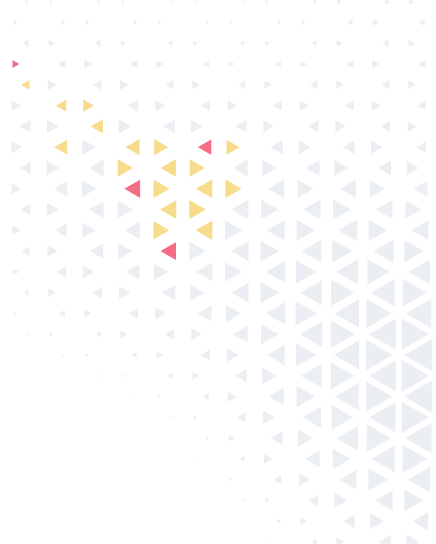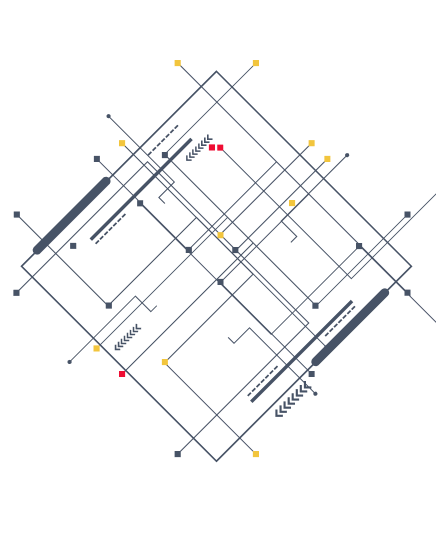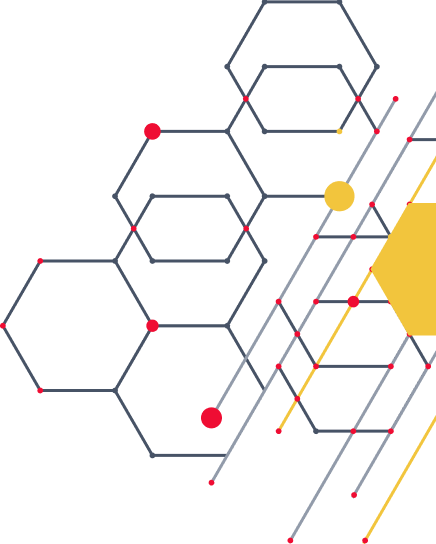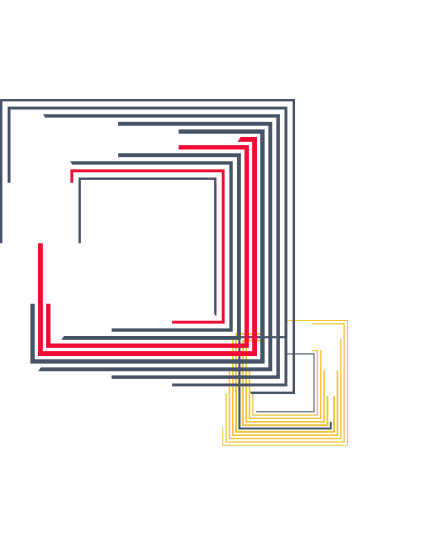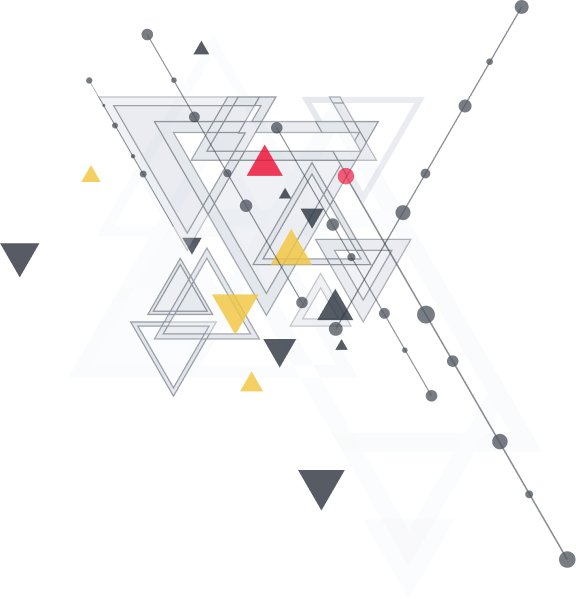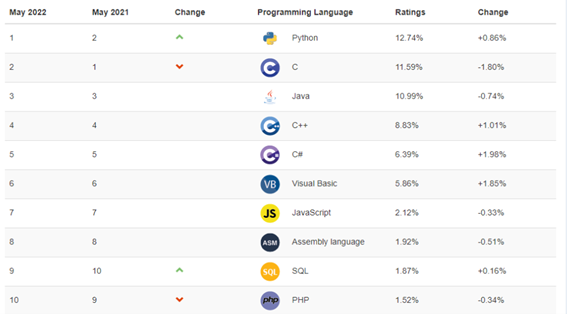Traditionally and jokingly speaking, libraries are those places that not only talk wordy to us but also have the shhh and novel prescription for bibliotherapy factors. Taken to the programming languages field, we can extrapolate that libraries speak cody to us. Jokes aside, in programming, libraries are collections of pre-compiled and re-usable files, routines, scripts, programs, or functions that are reproduced in the programming code. Given its beginner-friendly nature and the richness of available toolkits and libraries, Python has become a cornerstone in Python development and a first-choice programming language for many developers. In today’s article, we will focus on some of the most common Python libraries worth taking a look at.
Python – a first-choice programming language
As of May 2022, the TIOBE Index ranks Python as the most popular programming language:
The increasing popularity of Python is also confirmed by the PYPL Index: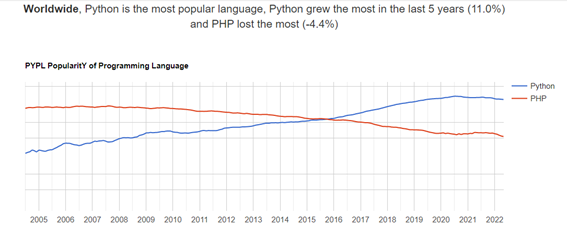
But what is it exactly that makes Python such a popular choice among developers? Let’s take a look at some of the benefits this programming language brings to the table:
Ideal for beginners
Thought out as a general-purpose language, Python has a simplified syntax that makes it easy to learn and use.
Dynamic and vast community support
Over the past 30 years, the Python community has evolved and matured, offering active support to beginners and experts alike.
Wide array of available libraries and frameworks
Python boasts excellent and wide-ranging libraries, saving developers a lot of valuable time and effort.
Ideal for custom automation
Thanks to its incorporated tools and modules that help automate time-consuming and repetitive tasks, Python is often developers’ first-choice when it comes to automation scripts.
Ideal for Big Data, ML, and Cloud Computing
While it is true that, in terms of popularity among programmers, R comes first, Python is still a good choice when it comes to data science and analytics solutions.
Flexible, fast, efficient, and reliable
Given its general-purpose nature, Python can be used to develop a virtually infinite array of apps in ML, AI, web development, data analytics, science, etc. Even if it has a slower execution speed than other programming languages (e.g. C++ or JavaScript), Python is unsurpassable when it comes to development time efficiency.
Let’s take a look at some of the most commonly used Python libraries:
TensorFlow
This open-source, Python-friendly library for wide-ranging ML and numerical computation was developed by Google to facilitate the creation and training of neural networks and ML models.
Main features:
- Delivers a practical front-end API for the development of deep learning and ML algorithms
- Its graphical approach ensures improved data visualization
- TensorBoard allows for easy and intuitive debugging of nodes
- Uses TPU, allowing for faster computation than GPU and CPU
- Since it provides multiple levels of abstraction, developers can choose the one that best suits their requirements
- Compatible with other programming languages such as JavaScript, C++, C#, Ruby, etc.
- Supports Linux, Windows (limited set of features), macOS, and Android
- The library is supported by Google, translating into seamless performance and frequent updates and new releases
- Supports various add-on libraries such as Ragged Tensors, BERT, TensorFlow Probability, etc.
Among its most popular uses, we can highlight:
- Image recognition (used for social media, mobile companies, image search, image recognition in healthcare, etc.)
- Video detection (used for gaming controls, security checks, automation, movement detection, etc.)
- Voice recognition (used for CRMs, search engines, security systems, digital assistants, etc.)
- Text-based apps (used for sentiment analysis, threat detection, language detection, summarization, etc.)
Scikit-Learn
Scikit-Learn is an open-source library for statistical modelling and ML. Interoperable with Matplotlib, SciPy and NumPy, this user-friendly library offers algorithms for a wide variety of data mining and ML tasks (e.g. model selection, preprocessing, classification, regression, clustering, etc.) and is one of the best libraries for data modeling. It provides tools such as NeuralNet, RandomForest, etc. The main disadvantage: Scikit-Learn is not the ideal option for deep learning.
Main features:
- The Python interface allows for the implementation of a vast repertoire of algorithms for ML, pre-processing, cross-validation, and visualization
- The BSD licence makes it free to use with very few licensing and/or legal restrictions
- Versatile and user-friendly, this library is the ideal choice for practical tasks such as text clustering, consumer behaviour prediction, sentiment analysis, creating neuroimages, etc.
- Backed up by a vast international community
- Accessible and detailed API documentation that makes it easy to integrate with platforms
Among its most popular uses, we can highlight:
- Recommendation engines (e.g. Spotify, Netflix, etc.)
- Financial cybersecurity analytics (e.g. credit/debit card fraud detection)
- Neuroimaging
NumPy
Ideal for scientific computing, this open-source Python library provides a rich collection of high-level mathematical functions, allowing programmers to swiftly execute matrices and large multidimensional arrays. NumPy is the ideal choice for basic linear algebra, sorting, mathematical and logical operations, Fourier transforms, basic statistical operations, I/O, etc. However, what makes NumPy stand out is its N-dimensional array object feature.
Main features:
- NumPy arrays are used by multiple scientific/mathematical packages based on Python
- Facilitates advanced mathematical operations and other operations that involve large numbers of data
- Provides a plethora of transformation, mathematical, and algebraic functions
- Includes random number generators
- Provides tools for integrating Fortran and C/C++ code
- If compared with Python Lists, its data structures are faster and take up less memory
Among its most popular uses, we can highlight:
- Probability and statistics
- Disaster management (using the Fourier transform function)
- Financial analysis
- Scientific computing
- Gaming
Chainer
Intuitive, robust, and flexible, Chainer is an excellent choice for implementing, training, and evaluating deep learning models in a straightforward way. It was specifically designed to make building complex neural networks simple and efficient.
Main features:
- Unique define-by-run approach (i.e. the network is defined dynamically on-the-fly). Chainer uses forward computation
- Incorporates a GPU-based numerical computation library
- Supports multiple network architectures (e.g. feed-forward nets, per-batch architectures, recurrent nets and recursive nets, etc.)
- Supports CUDA computation
- Provides an imperative declaration of neural networks
Among its most popular uses, we can highlight:
- Transportation (e.g. autonomous driving)
- Manufacturing industry (industrial robots, plant automation, machine tools, etc)
- Healthcare (medical images for predicting malignant cells)
- Academia (computer vision, speech and natural language processing, robotics, etc.)
Matplotlib
Matplotlib is THE CHOICE when it comes to dimensional plotting. Platform-independent and open-source, this Python-based library can be run on Linux, Windows, Sun Solaris, and Mac OS and can be used with other libraries such as NumPy or SciPy. It provides a plethora of functions that allow programmers to design high-quality scatter plots, pie charts, log plots, histograms, images, filled curves, etc.
Main features:
- User-friendly, easy to learn, customizable, and extensible
- Provides high-quality plots and images and supports various formats (e.g. .pdf, .png, .pgf, etc.)
- Ideal for performing data exploration for ML projects
- Unbeaten level of granular control
- Ideal for interactive, static, and animated visualizations
- Its functionality can be extended with user-contributed and third-party packages (e.g. Mplot3d for 3-D plots, Basemap for map plotting, Natgrid for irregularly spaced data, etc.)
Among its most popular uses, we can highlight:
- Plotting geographical data
- Plotting data from websites or databases
- Interactive applications (e.g. weather radar app)
Wrap up
Flexible, efficient, reliable, easy to learn, and – above all – backed up by a vibrant support community and a wealth of libraries and frameworks, Python is nowadays a first-choice programming language for developers of all skill levels. Google, Spotify, Yahoo Maps, or Quora are only some of the giants that use Python. Obviously, choosing a programming language or, on this particular occasion, a library over another highly depends on your project’s goals and needs.
